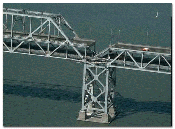|

San Francisco's City Hall the day before the 1906
San Francisco earthquake and resulting fire.
�

Because of the earthquake, over half of the city's
population of 400,000 were left homeless to live in
tents.
�

It has been speculated that most of the damage in
the 1906 quake was caused not directly by the
earthquake itself, but by the resulting
inflagration.
�

The 1989 Loma Prieta earthquake resulted in a
collapse of the middle portion of the Bay Bridge..
Motorists were trapped and killed between the
beams, accounting for many of the injuries and
deaths in that area.
�

This garage collapsed because of the earthquake and
poorly built apartments above it.
|
General Earthquake
Facts
1. In 1769, the earliest
reported earthquake was felt by Spanish explorers.
It took place about 30 miles southeast of Los
Angeles.
2. The average range of motion
along the San Andreas fault zone is about 2 inches
per year, about the same rate of growth of human
fingernails.
3. When primitive seismographs
were first built in 1751, no one knew the reason
earthquakes happened. That wasn't discovered until
1855, when faults were determined to be the source
of earthquakes.
4. Many people think that the
words "tsunami" and "tidal wave" are
interchangeable. However, they are two unrelated
phenomena. A tidal wave is a large wave produced by
high winds, while tsunamis are initially caused by
an underwater earthquake, which displaces ocean
water relatively quickly.
5. In an earthquake, the
hypocenter is the origin of the rupture of the
fault. The epicenter of the earthquake is located
directly above the hypocenter, on the
surface.
6. It is a popular opinion that
more damage was done during the fire after the 1906
San Francisco earthquake than by the earthquake
alone.
7. A seiche ("SAYSH") is the
movement of water in a body of water caused by the
ground shaking in an earthquake. It often happens
in swimming pools during a California earthquake. A
seiche can continue from minutes to hours after
original force is gone. It can also be caused by
wind or tides.
8. Every year, southern
California has an average of about 10,000
earthquakes. The majority of these quakes are minor
and go unnoticed by the general public. Only a few
hundred of these quakes are above an M3.0, and
about 15-20 are greater than M4.0. If a large
earthquake takes place, the aftershocks will
continue for many months.
9. The magnitude of an
earthquake is the measure of how big an earthquake
is. It does not vary with location. However, the
intensity of an earthquake is how much shaking is
generated by an earthquake. The intensity does vary
with location.
10. There are many people who
attribute earthquakes with muggy weather or
unseasonably cold weather, but science determines
that there is no correlation between earthquakes
and weather. There is an equal likelihood of
earthquakes in warm, cold, rainy, foggy, and windy
weather. There is no physical way for the weather
to affect the forces beneath the earth's surface.
Barometric pressure on the earth's surface doesn't
affect the changes in the earth's crust because it
cannot go beneath the soil.
11. The typical depth of an
earthquake is about 50 miles below the earth's
surface.
12. The San Andreas fault is not
one single fault, but a series of faults called a
fault zone. Movement can occur along one section
along the fault zone at any time. This fault zone
is over 800 miles long, and up to 10 miles
deep.
13. In 350 B.C., Aristotle
discovered that soft ground (landfill) shakes more
than hard rock (bedrock) in an
earthquake.
14. European settlers first
experienced an earthquake in America in
1663.
�
California Earthquake
Facts
California's complex and
interesting landscape can be attributed to a
network of faulting running underneath the state.
Faults are seen when there are abrupt changes in
the structure of rocks. Typically, faults are
observed in seacliffs along the beach or places
where layers of rock are exposed.
Faults, including fault zones,
are classified by how the rocks on each side of the
fault move past each other. There are two different
kinds of faults: strike-slip faults and dip-slip
faults.
Strike-Slip
Faults
In a strike-slip fault, the rocks move past
each other horizontally. The San Andreas is a
good example of a strike-slip fault, having
displaced rocks up to hundreds of miles. The San
Andreas is not a single fault, but a fault zone,
where movement can occur on one section without
affecting another section. The effects of this
fault zone can be observed for more than 600
miles.
Dip-Slip Faults
Dip-slip faults are faults which move
parallel to one another, almost vertically. The
rocks that generally form ridges are called
horst, while the rocks that make up
valleys are called graben. When the dip
of a normal fault's surface is steep, it is
called a normal fault. Two examples of a normal
fault are the Sierra Nevada fault zone and the
Owens Valley fault zone. This created the Owens
Valley, an example of a graben.
A version of a dip-slip fault is called a
detachment fault, in which the dip of a fault
surface is nearly flat. These are common in the
deserts of California.
|
�
|